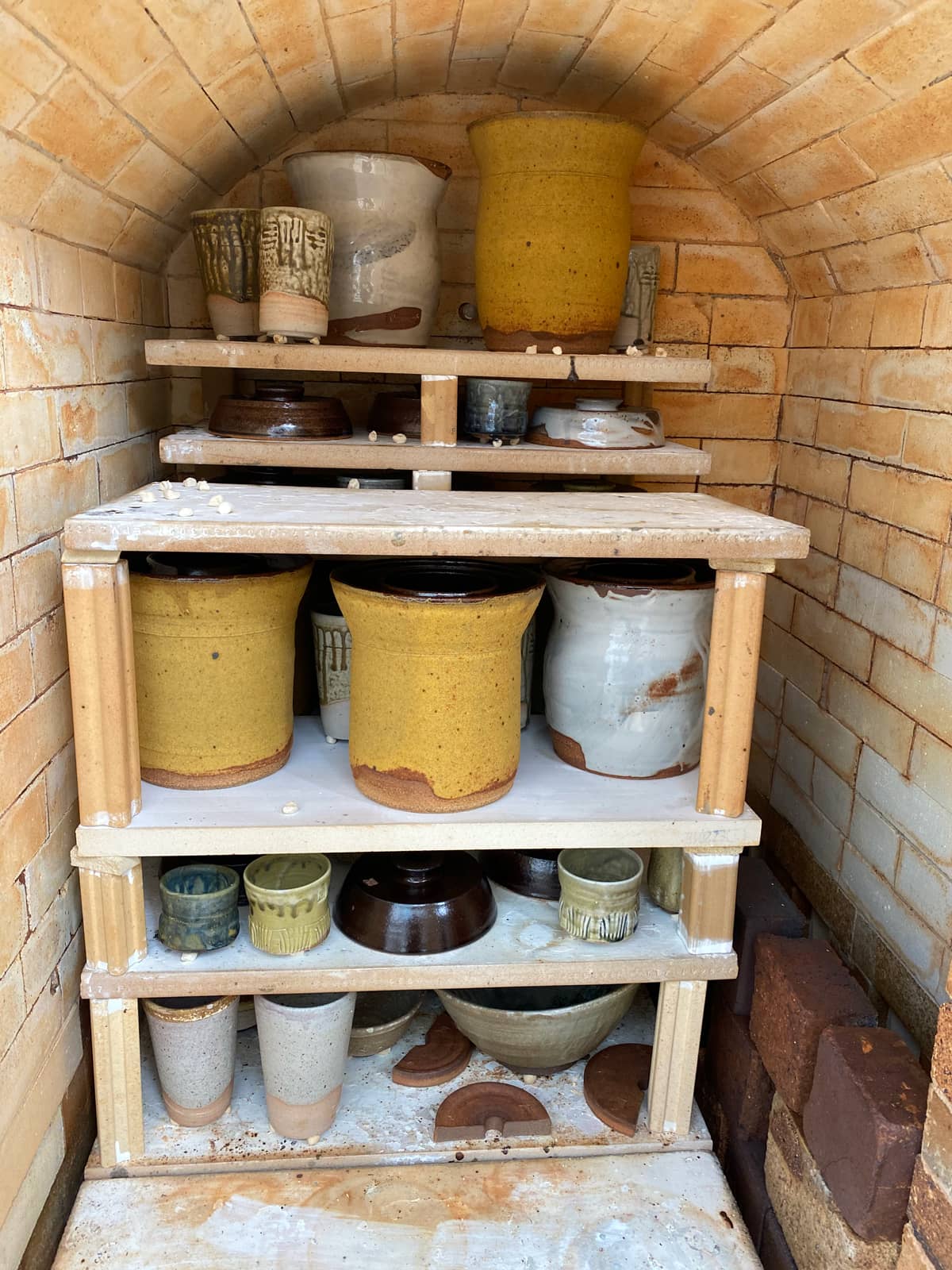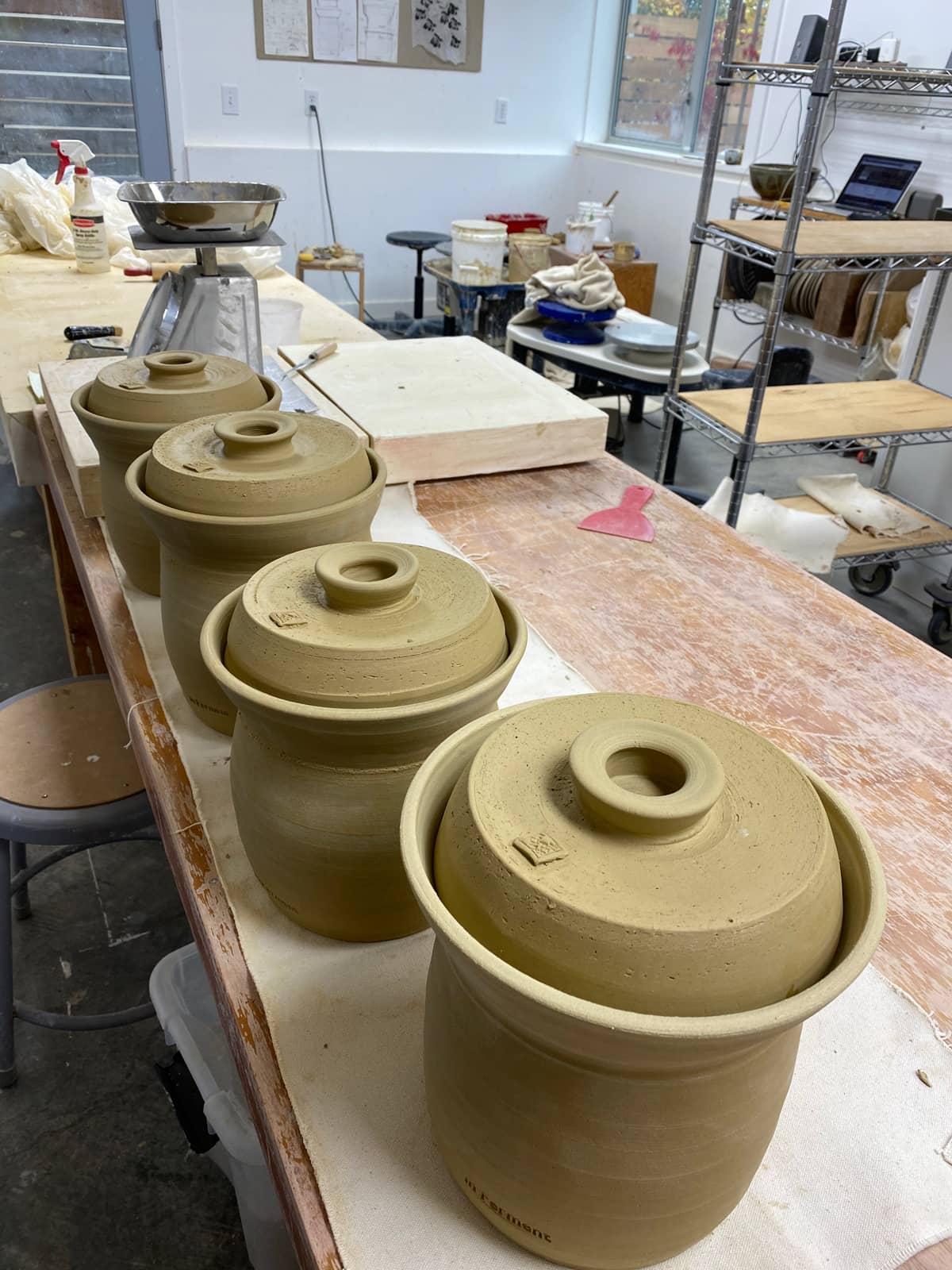Table of Contents
High Fire vs Low Fire Ceramics
In pottery, we distinguish between low-fire and high-fire processes. The primary difference is the temperature at which the clay is fired, which results in different properties and possibilities for the finished ceramics.
High Fire Ceramics
Our fermenting vessels are high-fire ceramics. High fire is stoneware or porcelain clay fired to a temperature between 1,100°C and 1,280°C (2,012°F – 2,336°F). The clay by itself becomes non-porous, in cases even vitrified. When fired in high fire and with the bond of glazing, the clay becomes a strong and durable material. The chemistry that occurs during the high fire is complex and beautiful due to heat and the ability to manipulate the kiln atmosphere. There are three main conditions of the kiln atmosphere:
- Oxidation
- Neutral
- Reduction
Low Fire Ceramics
Low fire is made from earthenware clay, such as the familiar Terracotta pots. Low fire provides porous clay that requires glazing for the practical use of storing liquid and cleaning. It is fired to temperatures between 600°C and 1,093°C (1112°F – 2,000°F), and since the chemical reactions of Reduction do not happen in the lower heat, there is mainly Oxidation condition in the kiln.
History of Stoneware
The Chinese were the first to develop high-temperature kilns capable of reaching up to 1350°C, to fire stoneware with a high-temperature melting point. China influenced Korea and Japan, which created a diverse school of kilns, clay-work and glazes.
Around 600 CE, China produced porcelain (a material with less than 1% porosity) from local kaolin clay. During the Middle Ages, trade through the Silk Road allowed for the introduction and diffusion of porcelain throughout Islamic countries first and later in Europe. Stoneware vessels were produced and fired in western Europe by 1325.
By the 15th century, the earliest blast furnaces were developed, capable of reaching up to 1,500°C. They were used to melt iron and were initially constructed from natural materials. When materials with better resistance to high temperatures (called refractories) were developed in the 16th century, the industrial revolution was born. It was then when many products were developed and manufactured by melting glass and firing porcelain on a massive scale.
Until today high fire ceramics vessels have remained durable with charming clay and glaze surfaces. The production process and the vessels, if used with non toxic minerals (mainly without lead) are sustainable and extremely pleasant. Each vessel is a unique piece of art that embodies thousands of years of culture and knowledge.
Process of High Firing Ceramics
The process of high fire ceramic production is long and intricate. High-level chemistry is involved from the first phase of preparing the clay through the glaze formulation to the last hours of cooling the kiln. There are also many steps and stages in the production, and the vessels have to stay intact under stressed conditions of drying, expansion and shrinkage. I want to describe the process in steps, so when you see a beautiful vessel, you would imagine the work invested in its making, the labor, knowledge, experience, skills, and time. And if you find yourself waiting several weeks for a vessel, you could envision what is happening here in the studio.
Here are the 4 basic steps:
- Shaping the vessel: (throwing on the wheel, trimming, hand-building)
- First fire (Bisque)
- Glazing
- Second fire (High fire)
1. Shaping
Shaping the vessel on the wheel is a fun phase; we are all familiar with watching the forms evolved from turning the wheel. However, it is essential to describe the importance of treating the clay beforehand.
The clay must be wedged thoroughly to become a solid chunk of material without air pockets. Sometimes we add more minerals to affect the glaze or combine particles in different sizes to strengthen the clay body or reduce its shrinkage.
Trimming is done after shaping the vessel and let it dry. Trimming is essentially shaping the base of the vessel by carving clay out.
Besides the wheel-work, hand-building work is added, including handles, knobs, and spouts, or manipulating the form artistically and adding texture.
After the pot is done with its shaping, it has to dry without developing cracks. Porcelain, in particular, require slow drying.
2. First Fire (Bisque)
Firing the first time (Bisque) moderates the shrinkage in the high temperature and creates a solid wall to receive the liquid glaze without disintegrating.
After the pot is done with its shaping, it has to dry without developing cracks. Porcelain, in particular, requires slow drying.
3. Glazing
In the studio, we mix the glaze from bulk minerals and oxides. Some glaze-mixes are taken from known formulas, but some alter or change to achieve a certain look and texture or improve the coefficiency bond with the clay.
Many of our glazes are Ash Glazes. We collect the ash from local burnet northwest trees. Each tree produces ash that contains different minerals which the tree had been fed from the soil. This is important because the same glaze formula can have completely different properties when the ash component is a different tree-ash; for example, Douglas Fir ash is very different from Pine tree ash in the same glaze formula.
Ash glazes tend to be “runny,” which is a term describing the glaze dripping on the surface of the pot. However, ash glazes are unique in their look of earthiness, resemble a rock, rich in subtle colors and depth. Since the ash is not a pure material, ash glazes always bring unpredictable results during the high fire.
Each vessel is glazed individually, and it is then when we start planning its location in the kiln to make sure the glaze fits the slight variations of the atmosphere in the kiln.
4. Second Fire (High Fire)
High fire stoneware and porcelain start with “Loading the kiln”. Loading the kiln is like a three-dimensional matrix of matching, not only the variations of sizes in the volume of the kiln but also the type of glazes to the kiln’s right location, i.e., proximity to the heat source, top verse bottom, etc.
The firing itself lasts for 12-16 hours, in which we control the heat rise and manipulate the kiln’s atmosphere. Then we let the kiln cool down for 48 hours from 1,260°C (2300°F) to prevent glaze defects and cracks.
We look for glaze drips to grind during unloading as part of getting the piece ready for packing and shipping. The unloading is always a celebration full of surprises, sometimes not pleasant ones, but overall, it is a warming heart feeling to see the results after a long journey.
FAQs
What is a ceramic material?
Ceramics are bonded oxide compounds that make them durable over millenniums. Once the mix has been introduced to heat in the kiln, they change their molecule form and cannot return to their pre firing condition. This is different then other materials, for example pure glass, which can be reused repeatedly.
What is clay?
Clay is a mixture of minerals, mostly feldspars and quartz with a unique property of plasticity, which is a product of its reaction to water. Water glues and lubricates the particles. Most of the minerals in the clay exist in the form of oxides, i.e., material that broke down from a parent rock and combined with oxygen.
Clays vary in their properties because of two main reasons:
- Their minerals have been weathered and departed from the parent rock in different ways. Such clay can be found in the mountains.
- Sedimentary clay; clay that was transported over time from miles away and settled. However, it has been ground and mixed with other minerals during the journey.
Most of the clay that we use in the studio has been collected by mining operations and synthesized, then combined in a formula to have certain properties to perform for our preferable designs. Occasionally though, we go “clay hunting” on the shores of Puget Sound.
Is the same clay used for low fire and high fire?
The term high-fire and low-fire is based on the temperature, in which the clay matures and reaches its strength before melting.
High fire clay
High fire clay has a high percentage of aluminum silicate (xAl2O3·ySiO2·zH2O), which its melting point is very high.
Porcelain
Porcelain has mostly kaolin, which is the purest form of aluminum silicates, and hence has a high resistance to heat. The name kaolin derives from the Chinese word Gaoling “High Ridge.”
Terracotta
Earthenware (terracotta) is clay fired at low temperatures where it does not develop maturity and is not vitrified. Many massive production ceramic factories use a middle range of clay to achieve strength, though not vitrification, but depend on glazing coat for applying functionality.
What is glaze?
Glaze is a coating for ceramics made from powdered ceramic minerals. The kiln fires decompose these materials down to their basic building blocks (called oxides). During the cooling process, a new form of matter is created: a glass material that cannot be reversed to its original powdered minerals in the recipe mix.
Similar to clay, the powdered minerals come in bulk from mining operations and are mixed in a formula to achieve certain properties such as melting point, mesh size, volatilization solubility, thermal expansion, surface tension, viscosity, and toxicity (or in fact, the lack of toxicity). We mix our glazes in the studio and often modify, change, or tweak the formula to create a look that fits the studio’s aesthetics, such as reducing shininess, increasing thickness, reducing runniness, modifying the color, etc.
Due to the high heat, most of the colorants burned off, so high fire glazes tend to look earthy and mute, ranging from the different whites, browns, blacks, grays and blues.
Are ceramics toxic or hazardous?
Ceramics have two realms of hazards:
- The studio environment where ceramists deal with powdered minerals and toxic materials for the skin.
- Leaching, which can occur when toxins seep through the glaze to the food served or stored in the ceramic dish/crock.
We do not have lead and barium in the studio as part of our material inventory. We do not use glazes that contain minerals oxides that could leach into the functional kitchenware. Most materials are safe after the firing when the silica bonds the minerals together and keeps a safe coat preventing them from leaching.
We use a nontoxic liner glaze on the interior of all functional ware. Our liner glazes are considered in the safest category: Iron-based glazes such as our Earth glaze, White and Shino-derived glazes such as our Aspen, Forest and Birch glazes, or the variety of Clear glazes such as our Pacific Sound glaze.
However, I want to emphasize that none of our glazes used on the exterior has leaching properties or toxin materials, such as the beautiful yellow Desert glaze.
And for the studio health, we keep an Air Filter machine and follow a safety protocol for cleaning and glaze mixing, including wearing respirators and gloves. The toxic materials for skin are toxic only before they bond with silica in the high fire, for example, Soda-Ash or Wood-Ash that have alkali when mixed with water.
How does high fire firing work?
“The interaction of oxygen and combustibles inside a brick box is an intricate and somewhat mysterious process to most people” (John Britt High fire glazes). During the firing there are specific length of time when the atmosphere is manipulated to create the desired reduction or neutral environment in the kiln. In order to be able to reproduce the glaze look and document the knowledge of firing we record a “firing schedule” which describes the actions and events occurring during the firing. Generally, it takes 24 hours to fire and 48 hours to cool down.








